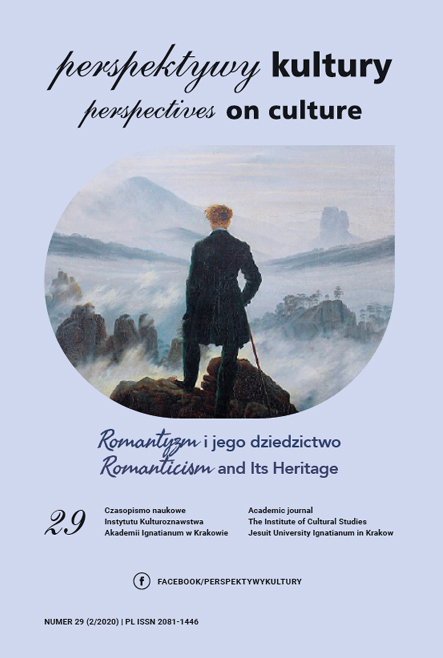Lost Sensoria: Anthropological Research on Sensory Experience in the Context of Multiculturalism
Abstract
Sensory experiences have generated a diverse sociological, anthropological and psychological literature. This paper illustrates an approach to the idea of lost sensoria and their social and cultural manifestations. Images of sensory experience, postulated synchronicity of sensory processes and the concept of ethnopoetics constitute a theoretical basis for the concept of lost sensory experience.
References
Agawu, K. (1995). African Rhythm: A Northern Ewe Perspective. Cambridge: Cambridge University Press.
Ahearn, L.M. (2013). Antropologia lingwistyczna. Wprowadzenie. Kraków: Wydawnictwo Uniwersytetu Jagiellońskiego.
Basso, K. (1996). Wisdom Sits in Places: Landscape and Language Among the Western Apache. Albuquerque: University of New Mexico Press.
Bodzioch-Bryła, B., Dorak-Wojakowska, L. & Smołucha D. (2017). Wzrokocentryzm, wizualność, wizualizacja we współczesnej kulturze. Kraków: Wydawnictwo Naukowe Akademii Ignatianum.
Cascio, C.N., O’Donnell, M.B., Simons-Morton, B.G., Bingham, C.R. & Falk, E.B. (2017). Cultural context moderates neural pathways to social influence. Culture and Brain, 5, 50–70.
Cereceda, V. (2007). O pewnych aspektach estetyki ajmarsko-andyjskiej: Od pojęcia piękna do tinku. In: K. Zajda (ed.), Estetyka Indian Ameryki Południowej. Antologia. Kraków: Universitas, 19–31.
Classen, C. (2012). The Deepest Sense A Cultural History of Touch. Urbana– Chicago–Springfield: University of Illinois Press.
Collins, R. (2004). Interaction Ritual Chains. Princeton–Oxford: Princeton University Press.
Crickmay, L. (1988). Transmission of Knowledge through Textiles: Weaving and Learning How to Live. In: H. Stobart & R. Howard (eds.), Knowledge and Learning in the Andes: Ethnographic Perspectives. Liverpool: Liverpool University Press, 40–55.
Darley, A. (2000). Visual Digital Culture Surface Play and Spectacle in New Media Genres. London–New York: Routledge.
DeBernardi J. (1994). Social Aspects of Language Use. In: T. Ingold, Com¬panion Encyclopedia of Anthropology. London–New York: Routledge, 861–890.
Dransart, P. (1988). Coloured Knowledges: Colour Perception and the Dis¬semination of Knowledge in Isluga, Northern Chile. In: H. Stobart & R. Howard (eds.), Knowledge and Learning in the Andes: Ethnographic Per¬spectives. Liverpool: Liverpool University Press, 56–78.
Duranti, A. (1997). Linguistic Anthropology. Cambridge: Cambridge Univer¬sity Press.
Duranti, A. (2015). The Anthropology of Intentions: Language in a World of Others. Cambridge: Cambridge University Press.
Evans, M. & Whittaker, A. (2010). Sensory Awareness and Social Work. Exeter: Learning Matters Ltd.
Friedrich, P. (2006). Maximizing Ethnopoetics: Fine-tuning Anthropolo¬gical Experience. In: Ch. Jourdan & K. Tuite (eds.), Language, Culture, and Society: Key Topics in Linguistic Anthropology. Cambridge: Cambridge University Press, 207–228.
Geurts, K.L. (2002). On Rocks, Walks, and Talks in West Africa: Cultural Categories and an Anthropology of the Senses. Ethos, 30(3), 178–198.
Ingold, T. (ed.). (1994). Companion Encyclopedia of Anthropology. London– New York: Routledge.
Jourdan, Ch. & Tuite, K. (eds.). (2006). Language, Culture, and Society: Key Topics in Linguistic Anthropology. Cambridge: Cambridge University Press.
MacLaury, R.E., Paramei, G.V. & Dedrick, D. (eds.). (2007). Anthropology of Color: Interdisciplinary Multilevel Modelling. Amsterdam–Philadelphia: John Benjamins Publishing Company.
Manghani, S., Piper, A. & Simons, J. (eds.). (2006). Images: A Reader. Lon¬don–Thousand Oaks: Sage Publications Ltd.
Pradier, J.-M. (2012). Ciało widowiskowe. Etnoscenologia sztuk widowisko¬wych. Warszawa: Wydawnictwo Naukowe PWN.
Schechner, R. (2006). Performatyka: Wstęp. Wrocław: Ośrodek Badań Twór¬czości Jerzego Grotowskiego i Poszukiwań Teatralno-Kulturowych.
Tuomela, R. (2013). Social Ontology: Collective Intentionality and Group Agents. Oxford: Oxford University Press.
Waskul, D. & Vannini, P. (2006). Body Embodiment: Symbolic Interaction and the Sociology of the Body. Aldershot–Hampshire, Ashgate Publishing, Ltd.
Wilson, D.S., Timmel, J.J. & Miller, R.R. (2005). Cognitive Cooperation: When the Going Gets Tough, Think as a Group. In: N. Gold (ed.), Teamwork: Multi-Disciplinary Perspectives. Houndmills–Basingstoke– Hampshire–New York: Palgrave–Macmillan, 33–55.
Copyright (c) 2020 Jesuit University Ignatianum in Krakow

This work is licensed under a Creative Commons Attribution-NoDerivatives 4.0 International License.
Autor, zgłaszając swój artykuł, wyraża zgodę na korzystanie przez Wydawnictwo Uniwersystet Ignatianum z utworu na następujących polach eksploatacji:
- utrwalania utworu w formie papierowej, a także na nośniku cyfrowym lub magnetycznym;
- zwielokrotnienia utworu dowolną techniką, bez ograniczenia ilości wydań i liczby egzemplarzy;
- rozpowszechniania utworu i jego zwielokrotnionych egzemplarzy na jakimkolwiek nośniku, w tym wprowadzenia do obrotu, sprzedaży, użyczenia, najmu;
- wprowadzenia utworu do pamięci komputera;
- rozpowszechniania utworu w sieciach informatycznych, w tym w sieci Internet;
- publicznego wykonania, wystawienia, wyświetlenia, odtworzenia oraz nadawania i reemitowania, a także publicznego udostępniania utworu w taki sposób, aby każdy mógł mieć do niego dostęp w miejscu i czasie przez siebie wybranym.
Wydawca zobowiązuje się szanować osobiste prawa autorskie do utworu.





